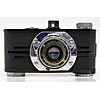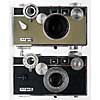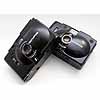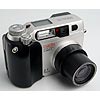... A Photo Enthusiast's Perspective
Feel free to disagree with me but this is the top 12 cameras
of all time from the perspective of this photo/camera enthusiast.
What would make your list? Add your
opinion to the comments. The cameras are listed in roughly
chronological order:
Kodak Box Brownie
- Before the Brownie photography was the exclusive preserve of the
rich. Eastman made a cumbersome, technical, expensive process
available to just about anyone. Before the 1900 launch of the
brownie, Eastman had been lowering the entry point for amateur
photographers with the introduction of daylight loading, roll film and
folding vest cameras, but the Brownie cost $1 and used film that cost
15c. No focusing or pesky shutter speeds and apertures to
deal with, simply press
the button and we'll (Kodak) do the rest.
Leica II
- Leica's importance in the history of cameras is undeniable
but why the II not the I? The II was the first real 35mm
system and it introduced the rangefinder as the focusing mechanism. The
Germans
reigned supreme until the Japanese revolution at the end of the 60's
when they forgot how to innovate and never caught up again.
 Argus
A - The Leica I was all well and good if you
had money to
burn. The Argus A was the American Leica I for those of more
limited
means but it is probably THE camera that ensured the success of the
35mm
format. It had a collapsible lens like the Leica and
resembled the
Leica in many ways at first glance. However, the A's body was
Bakelite
(the first plastic camera?) among other innovations.
Argus
A - The Leica I was all well and good if you
had money to
burn. The Argus A was the American Leica I for those of more
limited
means but it is probably THE camera that ensured the success of the
35mm
format. It had a collapsible lens like the Leica and
resembled the
Leica in many ways at first glance. However, the A's body was
Bakelite
(the first plastic camera?) among other innovations.
 Argus C3 -
The brick,
as it was/is affectionately named, carried on the A's
tradition of democratizing Leica's technology in an affordable,
reasonably spec'd camera. One of the best selling cameras of
all time,
the C3 introduced interchangeable lens and rangefinder focusing to the
mass American audience. Although targeted directly at the
enthusiast
the C3 was, nevertheless, capable of very professional results.
Argus C3 -
The brick,
as it was/is affectionately named, carried on the A's
tradition of democratizing Leica's technology in an affordable,
reasonably spec'd camera. One of the best selling cameras of
all time,
the C3 introduced interchangeable lens and rangefinder focusing to the
mass American audience. Although targeted directly at the
enthusiast
the C3 was, nevertheless, capable of very professional results.
Nikon F
- Before the Nikon F, the professional standard for a photo-journalists
35mm camera was an expensive, German rangefinder. The F
proved that Japan was now an innovator rather than a cheap copyist.
SLR technology had come of age; the F was built like a
beautiful tank proving itself reliable and rugged. Still, if
you want to look like a war photographer you should pick up an old
F.
 Olympus OM1 - Japanese 35mm SLRs had
proved their metal but they
were much more bulky than the old German rangefinders. The
OM1
elegantly slimmed down the SLR's profile with a more
architectural
aesthetic rather than its forerunner's industrial designs without
sacrificing any durability or features. The OM system was the
system
of choice for many photo-journalists, travel photographers and
scientific (especially astrological and macro) photographers.
Olympus OM1 - Japanese 35mm SLRs had
proved their metal but they
were much more bulky than the old German rangefinders. The
OM1
elegantly slimmed down the SLR's profile with a more
architectural
aesthetic rather than its forerunner's industrial designs without
sacrificing any durability or features. The OM system was the
system
of choice for many photo-journalists, travel photographers and
scientific (especially astrological and macro) photographers.
Canon AE1
- The first camera with an embedded micro-computer; either
the beginning of the end or the start of a revolution depending upon
your point of view.
 Pentax
K1000 - Not innovative, especially well featured or pretty
the K1000
still makes my list.Why? Because it is the camera a
generation or
two of professional and enthusiast photographers learnt their
craft/art on. It's lack of pretension and unnecessary
features
allowed/allows a student to learn photography without the camera
getting in the way. It was the required camera for many
college-level photography classes.
Pentax
K1000 - Not innovative, especially well featured or pretty
the K1000
still makes my list.Why? Because it is the camera a
generation or
two of professional and enthusiast photographers learnt their
craft/art on. It's lack of pretension and unnecessary
features
allowed/allows a student to learn photography without the camera
getting in the way. It was the required camera for many
college-level photography classes.
 Olympus XA - a fully-featured 35mm
rangefinder in a pocket able,
cam-shell case - the influence of the XA is hard to miss in all
point-and-shoot designs that followed. It became the pocket camera
for professionals and enthusiasts while the
consumer-orientated XA2 sold in even greater numbers to those less
concerned with rangefinder focusing and exposure control..
Olympus XA - a fully-featured 35mm
rangefinder in a pocket able,
cam-shell case - the influence of the XA is hard to miss in all
point-and-shoot designs that followed. It became the pocket camera
for professionals and enthusiasts while the
consumer-orientated XA2 sold in even greater numbers to those less
concerned with rangefinder focusing and exposure control..
 Minolta
7000 - Minolta was something of an also-ran
until the auto focus revolution. While Nikon, Canon and
Olympus ummed
and ahhed
Minolta steamed ahead with the first in-body, auto focus SLR. For a few
years, in the 80's, Minolta out sold everyone else combined in the 35mm
SLR market as they were the only game in town with a full auto focus
35mm system. Beyond auto focus the 7000 set the trends,
features and aesthetics for the plastic-wonderkind camera. In
an age when many cameras still were made from brass, chrome and leather
the angular, plastic 7000 looked positively space-age.
Minolta
7000 - Minolta was something of an also-ran
until the auto focus revolution. While Nikon, Canon and
Olympus ummed
and ahhed
Minolta steamed ahead with the first in-body, auto focus SLR. For a few
years, in the 80's, Minolta out sold everyone else combined in the 35mm
SLR market as they were the only game in town with a full auto focus
35mm system. Beyond auto focus the 7000 set the trends,
features and aesthetics for the plastic-wonderkind camera. In
an age when many cameras still were made from brass, chrome and leather
the angular, plastic 7000 looked positively space-age.
 Nikon
Coolpix
950 / Olympus C-2000Z - Two
of the first 2 megapixel, zoom lens cameras available for under a
thousand dollars; they add fuel to the digital revolution fire.
It was the end of the millennium and these were the first
digital cameras that enthusiasts could afford with image quality and
features sufficient to contemplate moving from film. They
sold very well and set the standard and format for all digicams that
followed.
Nikon
Coolpix
950 / Olympus C-2000Z - Two
of the first 2 megapixel, zoom lens cameras available for under a
thousand dollars; they add fuel to the digital revolution fire.
It was the end of the millennium and these were the first
digital cameras that enthusiasts could afford with image quality and
features sufficient to contemplate moving from film. They
sold very well and set the standard and format for all digicams that
followed.
Canon
Digital Rebel - At a time when the cheapest
digital SLR was
priced around $3000 Canon launched the 300D for less than $1000 with a
kit lens. Digital photography enthusiasts quickly moved from
high-end
digital point-and-shoots to the Digital Rebel and its
equivalents from
Nikon, Minolta, Olympus and Minolta. Enthusiasts reclaimed SLR
flexibility with consumer DSLRs becoming the fastest growing segment of
the camera industry.
Article created
in response to Problogger's Lists writing project.
 Argus
A
Argus
A 



 Minolta
7000
Minolta
7000